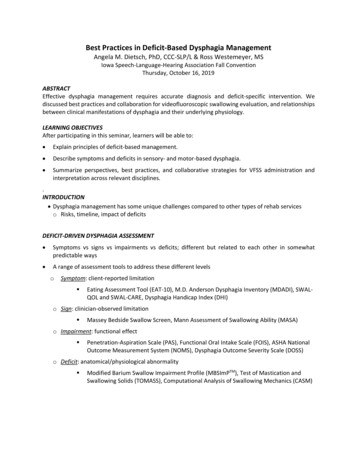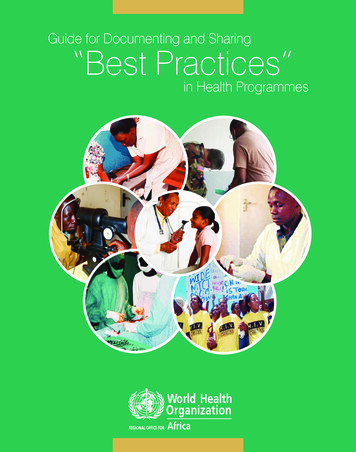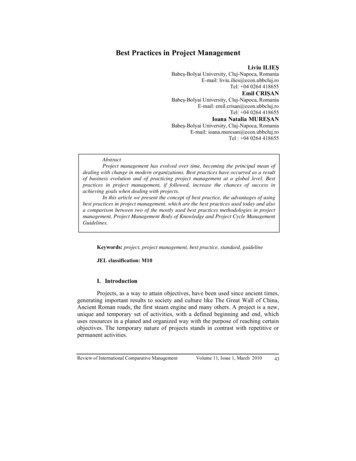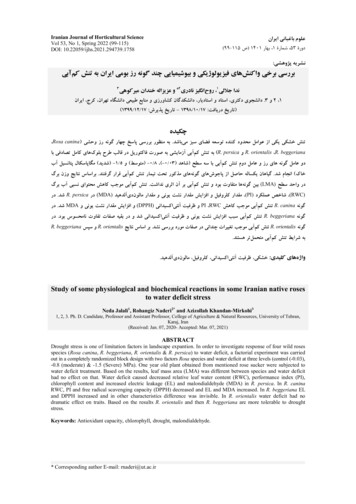
Transcription
Best Practices in Deficit-Based Dysphagia ManagementAngela M. Dietsch, PhD, CCC-SLP/L & Ross Westemeyer, MSIowa Speech-Language-Hearing Association Fall ConventionThursday, October 16, 2019ABSTRACTEffective dysphagia management requires accurate diagnosis and deficit-specific intervention. Wediscussed best practices and collaboration for videofluoroscopic swallowing evaluation, and relationshipsbetween clinical manifestations of dysphagia and their underlying physiology.LEARNING OBJECTIVESAfter participating in this seminar, learners will be able to: Explain principles of deficit-based management. Describe symptoms and deficits in sensory- and motor-based dysphagia. Summarize perspectives, best practices, and collaborative strategies for VFSS administration andinterpretation across relevant disciplines.INTRODUCTION Dysphagia management has some unique challenges compared to other types of rehab serviceso Risks, timeline, impact of deficitsDEFICIT-DRIVEN DYSPHAGIA ASSESSMENT Symptoms vs signs vs impairments vs deficits; different but related to each other in somewhatpredictable ways A range of assessment tools to address these different levelsoSymptom: client-reported limitation§Eating Assessment Tool (EAT-10), M.D. Anderson Dysphagia Inventory (MDADI), SWALQOL and SWAL-CARE, Dysphagia Handicap Index (DHI)o Sign: clinician-observed limitation§Massey Bedside Swallow Screen, Mann Assessment of Swallowing Ability (MASA)o Impairment: functional effect§Penetration-Aspiration Scale (PAS), Functional Oral Intake Scale (FOIS), ASHA NationalOutcome Measurement System (NOMS), Dysphagia Outcome Severity Scale (DOSS)o Deficit: anatomical/physiological abnormality§Modified Barium Swallow Impairment Profile (MBSImPTM), Test of Mastication andSwallowing Solids (TOMASS), Computational Analysis of Swallowing Mechanics (CASM)
Deficit-Based Dysphagia Management(Dietsch & Westemeyer) ISHA Nov 2019Page 2Indications of sensory, motor, and sensorimotor deficitso Sensory: somewhat stimulus-specific; over-responsivity, under-responsivity, stimulus-seekingo Motor: fairly consistent across circumstances; weakness, abnormal toneo Sensorimotor: breakdown in sensory processing/integration and/or formulating appropriatemotor response to stimulus; incoordination re: timing and amplitude of movements The nature of the deficit determines the management approachoNeed to consider additional factors such as developmental vs. acquired, acute vs. chronic, singleincident vs. degenerative, sensory vs. motor vs. sensorimotor vs. otheroAccurate identification of impairments and deficits is critical for treatment selection and successASSESSMENT BEST PRACTICES Some oral deficits may be identified via clinical assessment tools, but pharyngeal deficits requirevisualization of the relevant anatomy and physiology (FEES or VFSS) FEES requires specific additional training and mentorship for the clinician plus endoscopy equipmentand means to disinfect the equipment. VFSS requires specific training/mentorship, videofluoroscopic equipment, and collaboration withanother discipline.ooNeither Radiologists nor SLPs are solely responsible for interpretation of VFSS§Radiologist and SLP present throughout image acquisition§Both create a report but may prioritize different information depending onprofessional guidelines and perspective, leading to potential false dichotomyTeambuilding strategies§§Start from shared GOALS to avoid us/them mentality:1.accurate diagnosis of swallowing anatomy and physiology2.best possible patient-centered care3.balance between obtaining adequate images for assessment and minimizingradiation doseEstablish mutual respect for what each team member brings re: expertise by alldisciplines reviewing each other’s practice guidelines and relevant literature1.SLP: ASHA Guidelines for VFSS, Knowledge and Skills for VFSS2.Radiology: American College of Radiology and the American Association ofPhysicists in Medicine§Clarify specific approaches, outcome measures, and common language/terms such as“frame rate” versus “pulse rate” and desired field of view§Establish routine interactions, both formal and informal, between disciplines outsidethe VFSS suite: in-services, luncheons, happy hours, emails to share literature
Deficit-Based Dysphagia Management(Dietsch & Westemeyer)§ISHA Nov 2019Page 3Consider joint, formalized QA program with specified outcomes to guide revision ofstrategies as neededDEFICIT-DRIVEN DYSPHAGIA MANAGEMENT STRATEGIES Evidence-based dysphagia managementoStrive to balance scientific evidence (quantitative research studies), clinical experience(professional consensus statements, practice groups, evidence-based continuing education) andpatient circumstances (QoL, treatment burden, satisfaction surveys)oWe are not limited to the evidence in SLP journals! (More about that later today)Compensatory Strategies Immediate effects regarding bolus flow and/or airway protection, a bolus is present Some consideration of how strategies fit impairments, but not necessarily deficits Test (instrumentally) to determine whether they successfully reduce risks associated withimpairmentsOral/lingual control & propulsion Head tilt – no peer-reviewed published evidence but consistent with what we know of physics andphysiology (Logemann, 1983). Effortful swallow – strong support via multiple reports of improvements in linguapalatal pressures inyounger (Clark & Shelton, 2014, Fukuoka et al., 2013, and Steele et al., 2010) and older (Yeates et al. 2010) healthyadults. Noted improvements in linguapalatal and pharyngeal-tongue base pressures in HNC pts afterXRT (Lenius et al., 2015). Altered diet texture – meta-analysis of 22 papers found reduction in aspiration risk seen on VFSS butnot on clinical aspiration/pneumonia rates (Painter et al., 2017), another systematic review and metaanalysis of thin vs. thick liquid intake identified no difference in aspiration rates for those whoaspirated on thin (Kaneoka et al., 2017). IDDSI offers standardization and testing (Cichero et al., 2017). Chin down/chin tuck – solid evidence that this position facilitates tongue-to-palate contact pressuresfor oral containment (Hori et al., 2011). Additionally, duration of tongue base/pharyngeal wall contactpressure in healthy persons (Balou et al., 2014), as well as pharyngeal constriction ratio and pyriformresidue in patients status-post esophagectomy (Kumai et al., 2017). Chin up/neck extension – improved oral clearance times and completeness with chin up positioningduring VFSS status-post glossectomy (Furia et al., 2000; Halczy-Kowalik et al., 2015), but only considered forpatients with adequate laryngeal closure or who can simultaneously utilize supraglottic swallowbecause associated with earlier LVC closure and later HLE in healthy people (Calvo et al., 2017). Respiratory-swallow training – strong preliminary evidence of immediate improvement in tonguebase retraction per MBSImP rating (Martin-Harris et al., 2015).Temporal aspects (onset of pharyngeal response, pharyngeal transit time, etc.) Tactile-thermal stimulation (TTS) – very specific cold stimulation to anterior faucial arches has hadmixed results at best; little evidence regarding carryover to nutritive non-stimulated swallows withinsame person (Miyaoka et al., 2006; Regan et al., 2010; Rosenbek et al., 1998; Sciortino et al., 2003).
Deficit-Based Dysphagia Management(Dietsch & Westemeyer)ISHA Nov 2019Page 4 Altered liquid consistencies – multiple RCTs (Logemann et al., 2008; Robbins et al., 2008) and a systematicreview and meta-analysis (Kaneoka et al., 2017) conclude that thickened liquids are relatively successfulat immediately eliminating aspiration on VFSS (without regard to nature of dysphagia), but rates ofaspiration-related complications such as pneumonia in known aspirators was no different for thin vsthick liquids.Tongue base to posterior-pharyngeal wall contact Head turn – convincing evidence of increased duration of UES opening, decreased residual UESresistance/pressure (Balou et al., 2014), and (when combined with chin tuck) reduced vallecular residue(Nagy et al, 2016). Effortful swallow – strong evidence of improved pharyngeal pressures and faster UES opening inhealthy participants (Doeltgen et al., 2017), more complete pharyngeal constriction in healthy people (Fritzet al., 2014), and pharyngeal-tongue base pressures in patients post-XRT (Lenius et al., 2015). Masako (tongue-hold) exercise – immediate effects on a range of outcome measures in healthypeople (Fujiu-Kurachi et al., 2014; Hammer, Jones, Mielens, Kim, & McCulloch, 2014; Langmore & Pisegna, 2015; Slovarpet al., 2016).Hyolaryngeal excursion Mendelsohn maneuver – overwhelming evidence of immediate improvements in HLE withMendelsohn as measured with sEMG (Ding et al., 2002; Wheeler et al., 2008), manometry (Hoffman et al., 2012),and VFSS kinematics (McCullough & Kim, 2013) compared to control conditions in a range of healthy anddysphagic persons. Effortful swallow – fair support but depends on instruction and outcome measures as per twosystematic reviews (Ashford et al., 2009; Langmore & Pisegna, 2015). Effortful pitch glide – one study to date, preliminary evidence that low to high glide yields immediateimprovement in hyoid elevation and pharyngeal movements in healthy persons (Miloro et al., 2014).Laryngeal vestibular closure Chin tuck – chin tuck posture significantly reduces AP diameter of the laryngeal inlet in healthy people(Leigh et al, 2015) and increases the duration of LVC closure (Macrae et al., 2014). Supraglottic swallow maneuver (and variations) – research is old but consistently indicated tighterTVC closure with supraglottic, plus arytenoid-epiglottis approximation with super-supraglottic (Martinet al., 1993; Ohmae et al., 1996).Sensory deficits - Exploratory work is building a body of literature examining: coincidence of sensory deficits and dysphagia immediate effects of sensory stimulation on swallow functiono carbonation may possibly help? (Turkington et al., 2017)o for cold boluses, inconsistent evidence of more rapid swallow overall (Cola et al., 2010 vs. Michou et al.,2012); more consistent evidence of increase esophageal contractions (Choi et al., 2014; Elvevi et al., 2014).o good evidence of sour taste stimuli altering swallowing timing/mechanics (Lee et al., 2012; Logemannet al., 1995; Pauloski et al., 2013; Pelletier & Lawless, 2003); exploratory work for more palatable options(Dietsch et al., 2016).
Deficit-Based Dysphagia Management(Dietsch & Westemeyer)ISHA Nov 2019Page 5Rehabilitation Strategies Longer-term effects on swallowing physiology even when technique not being performed, oftenperformed when bolus is not present. Principles of exercise – specificity, intensity, load/resistance Several recent reviews of the dysphagia exercise literature (Ashford et al., 2009; Langmore & Pisegna 2015;McKenna et al., 2017; Rogus-Pulia & Connor, 2016; Waito et al., 2017).Oral/lingual control & propulsion Expiratory muscle strength training (EMST) - improved buccinator strength documented in one RCT(Park JS et al., 2016). Tongue-to-palate strength training – most studies use one of two commercial systems tomeasure/train pressures, mixed results at best re: functional bolus control effects despite consistentevidence of increased tongue-to-palate pressures (Lazarus et al., 2014; Namasivayam-MacDonald et al., 2017;Oh, 2015; Park JS et al., 2015; Robbins et al., 2005; Rogus-Pulia et al., 2016; Yeates et al., 2008). Deep pharyngeal nerve stimulation (DPNS) - no peer-reviewed published evidence Effortful swallow – moderate evidence of long-term benefits to tongue strength and oral manipulationin patient groups after 4-6 weeks of exercise (Clark & Shelton, 2014; Kraaijenga et al., 2017). Others notedhigher tongue-to-palate pressures in healthy persons after several weeks of training (Oh, 2015; Park T &Kim, 2016).Temporal aspects (onset of pharyngeal response, pharyngeal transit time, etc.) Tactile-thermal stimulation (TTS) – no evidence of sustained effects McNeill Dysphagia Therapy Program (MDTP) – improved functional outcomes reported in limitedtrials but several issues with controls and outcome measures (Carnaby-Mann & Crary, 2010; Crary, Carnaby,LaGorio, & Carvajal, 2012; Lan et al., 2012). Neuromuscular electrical stimulation (NMES) – Several commercial systems; most studies foundlittle benefit in comparison to “traditional therapy” in a range of patient groups; sensory level ofstimulation generally more favorable than contraction-eliciting level (Baijens et al., 2008; Byeon & Koh,2016; Christiaanse et al., 2011; Gallas et al., 2010; Heijnenet al., 2012; Lim et al., 2009; Xia et al., 2011; Zhang et al., 2016).Tongue base to posterior-pharyngeal wall contact Tongue-to-palate strength and accuracy training – Solid RCT evidence supports reduced vallecularresidue in post stroke population (Steele et al., 2016) but not BI (Steele et al., 2013). Effortful swallow - Mixed evidence for increased pharyngeal pressures, pharyngeal constriction ratios(summarized in Langmore & Pisegna, 2015); improved PCR shown when combined with NMES but no controlcondition (Kim et al., 2017). DPNS – no peer-reviewed published evidence Masako (tongue-hold) exercise – limited evidence of long-term benefit (Langmore & Pisena, 2015); onestudy compared Masako to NMES after stroke and found equal benefit after 5/wk x 4wks (Byeon, 2016b). Respiratory-swallow training – improved tongue base retraction sustained 1 month after treatment(Martin-Harris et al., 2015).
Deficit-Based Dysphagia Management(Dietsch & Westemeyer)ISHA Nov 2019Page 6Hyolaryngeal excursion Shaker/Chin tuck against resistance (CTAR) – Early Shaker literature strongly supports improvementsmaintained over time; more recent papers focus on CTAR vs Shaker with generally comparableresults for the two exercises (Easterling et al., 2005; Gao & Zhang, 2016; Logemann et al., 2009; Mishra et al., 2015;Sze et al., 2016; Yoon et al., 2014). EMST – strong evidence of improved hyoid displacement and/or improved respiratorysupport/coordination; results maintained in multiple patient populations; appropriate level ofresistance is key (Byeon, 2016a; Hegland et al., 2016; JS Park JS et al., 2017; JS Park et al., 2016; Plowman et al., 2016;Reyes et al., 2015; Troche et al., 2010; Troche et al., 2014). Tongue-to-palate strength training – One study identified greater anterior and superior hyoidmovements and UES opening in elderly patients with dysphagia symptoms after 2x/day tongue pressexercises over a month (Namiki et al., 2019) DPNS – no peer-reviewed published evidence MDTP – improvements reported in one uncontrolled study (Sia et al, 2015); no other published reports Mendelsohn maneuver – strong evidence of extended benefit in multiple well-controlled studiesincluding multiple populations and outcome measures (Ding et al., 2002; Hoffman et al., 2012; Langmore &Pisegna, 2015; McCullough & Kim, 2013). Effortful swallow – positive evidence of long-term benefit in some studies but differences in dosingand exercise regime confound interpretation of studies (Ashford et al., 2009; Kraaijenga et al., 2015; Langmore& Pisegna, 2015; JW Park et al, 2012); one study of patients with head/neck CA found no significant changesin HLE (Kraaijenga et al., 2017). NMES – some poorly controlled studies show limited benefit in comparison to or in combination with“traditional therapy” (Beom et al., 2015; Tang et al., 2017); others found no benefit in well-controlled studies(Christiaanse et al., 2011; Heijnen et al., 2012; Langmore et al., 2016; Ryu et al., 2009; Zhang et al., 2016) and evenreductions in HLE and swallowing safety depending on electrode placements (Humbert et al., 2006).Laryngeal vestibular closure Respiratory-swallow training – improved laryngeal vestibular sustained 1 month after treatment(Martin-Harris et al., 2015).Prophylaxis in head-neck cancer Several programs of exercise being evaluated (Cnossen et al., 2017; Govender et al., 2017; Kraaijenga et al., 2015;Mortensen et al., 2015; Ohba et al., 2016; Wallet al., 2016); key is compliance, recent systematic reviewsummarizes results of several key studies (Govender et al., 2017).Neuroplasticity- several types of exploratory work Transcranial magnetic stimulation – better recovery compared to sham maintained 3 months posttreatment, stimulate unaffected hemisphere, settings matter (Du et al., 2016; Kumar et al., 2011; Pisegna etal., 2016; Yang et al., 2015). TTS – increased neural activation in swallows with vs. without TTS (Teismann et al., 2009). Other tactile stimulation – Punctate saltatory facial stimulation (Rosner & Barlow 2016) led to longterm changes in oromotor neural cortex; vibration over the larynx (Mulheren & Ludlow, 2017) increasedbloodflow to swallowing-relevant regions.
Deficit-Based Dysphagia Management(Dietsch & Westemeyer)ISHA Nov 2019Page 7 Taste stimulation – several labs have shown increased cortical bloodflow to relevant regions with tastestimuli (Babaei et al., 2010; Humbert & Joel, 2012; Mulheren & Ludlow, 2017; Wahab et al., 2010); preliminary workin Dietsch lab is exploring the longer-term neuroplastic changes and recovery of swallowing motorpatterns associated with specific taste stimuli.Computer modeling – general and individualized computer models of human swallowing may enablebetter surgical and treatment planning.Summary Quantity and quality of evidence ranges widely Concerning trend toward most costly trainings/equipment having least extensive evidence base(DPNS, MDTP, NMES) Focus expanding to include multiple systems (respiratory, neural bases) as well as functionaloutcomes of interventions Building solid foundation of evidence is slow, requires collaboration between clinicians andresearchers to be relevant and reliableREFERENCES – these some key references that cover main principles of this presentation. For access to entirelist of references, please visit https://sisc.unl.edu/isha2019** designates review or meta-analyses papersAmerican College of Radiology and the American Association of Physicists in Medicine. (2013). ACR-AAPM technical standard formanagement of the use of radiation in fluoroscopic procedures.American Speech-Language-Hearing Association. (2004). Guidelines for speech-language pathologists performingvideofluoroscopic swallowing studies [Guidelines]. Downloaded from www.asha.org/policy.American Speech-Language-Hearing Association. (2004). Knowledge and skills needed by speech-language pathologistsperforming videofluoroscopic swallowing studies [Knowledge and Skills]. Downloaded from www.asha.org/policy.**Arvedson JC, Lefton-Greif MA. (2017). Instrumental assessment of pediatric dysphagia. Semin Speech Lang, 38(2), 135-146. doi:10.1055/s-0037-1599111** Ashford J, McCabe D, Wheeler-Hegland K, Frymark T, Mullen R, Musson N, . . . Hammond CS. (2009). Evidence-based systematicreview: Oropharyngeal dysphagia behavioral treatments. Part III--impact of dysphagia treatments on populations withneurological disorders. J Rehabil Res Dev, 46(2), 195-204.Cichero JA, Lam P, Chen J, Dantas RO, Duivestein J, Hanson B. . . Vanderwegen J. (2019). Release of updated internationaldysphagia diet standardization initiative framework (IDDSI 2.0). J Texture Stud, doi: 10.1111/jtxs.12481**Easterling, C. (2017). 25 years of dysphagia rehabilitation: What have we done, what are we doing, and where are we going?Dysphagia, 32, 50-54. doi:10.1007/s00455-016-9769-8International Atomic Energy Agency, Radiation protection of patients: fluoroscopy. Downloaded from rpop.iaea.org.Kleim JA, Jones TA. (2008). Principles of experience-dependent neural plasticity: Implications for rehabilitation after braindamage. J Speech Lang Hear Res, 51, S225-S239.**Langmore SE, Pisegna JM. (2015). Efficacy of exercises to rehabilitate dysphagia: A critique of the literature. Int J Speech LangPathol, 17(3), 222-229. doi:10.3109/17549507.2015.1024171**Lazarus CL. (2017). History of the use and impact of compensatory strategies in management of swallowing disorders.Dysphagia, 32, 3-10. doi: 10.1007/s00455-016-9779-6Martin-Harris B, Brodsky MB, Michel Y, Castell DO, Schleicher M, Sandidge J, Maxwell R, Blair J. (2008). MBS measurement toolfor swallowing impairment—MBSPImp: Establishing a standard. Dysphagia, 22(4), 392-405.Martin-Harris B, Carson KA, Pinto JM, Lefton-Greif MA. (2019). BaByVFSSImP A novel measurement tool for videofluoroscopicassessment of swallowing impairment in bottle-fed babies: Establishing a standard. Dysphagia, doi: 10.1007/s00455-01910008-x.Moro L, Cazzani C. (2006). Dynamic swallowing study and radiation dose to patients. Radiol Med, 111(1), 123-9.RadioGraphics. (2001). The AAPM/RSNA physics tutorial for residents. Downloaded from www.rsna.org.**Rogus-Pulia N, Connor NP. (2016). Muscle strengthening approaches to dysphagia rehabilitation. Current Phys Med RehabReports, 4(4), 277-86.World Health Organization. (2017). Towards a Common Language for Functioning, Disability and Health. Downloaded nnersguide.pdf?ua 1
Worksheet for Small-Group Application ActivityCase Studies in Dysphagia Assessment and ManagementPatient-ReportedSymptom logical DeficitSensory, Motor,Both, OtherPossible RehabStrategyEvidence Base for DeficitStrategy Match?
McNeill Dysphagia Therapy Program (MDTP) - improved functional outcomes reported in limited trials but several issues with controls and outcome measures (Carnaby-Mann & Crary, 2010; Crary, Carnaby, LaGorio, & Carvajal, 2012; Lan et al., 2012). Neuromuscular electrical stimulation (NMES) - Several commercial systems; most studies found











